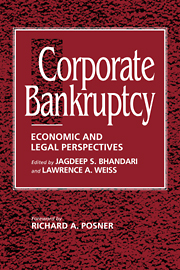Book contents
- Frontmatter
- Contents
- List of tables and figures
- Foreword by the HONORABLE RICHARD A. POSNER
- Preface
- Part I The role of credit
- Part II Bankruptcy as a reflection of the creditors' implicit bargain
- Part III Beyond the basic creditors' bargain
- Part IV Workouts or bargaining in the shadow of bankruptcy
- Part V Alternatives to bankruptcy and the creditors' bargain
- Part VI Experience of other countries
- 29 Lessons from a comparison of U.S. and U.K. insolvency codes
- 30 The costs of corporate bankruptcy: A U.S.–European comparison
- 31 Should we abolish Chapter 11? The evidence from Japan
- 32 The role of banks in reducing the costs of financial distress in Japan
- Index
31 - Should we abolish Chapter 11? The evidence from Japan
Published online by Cambridge University Press: 10 December 2009
- Frontmatter
- Contents
- List of tables and figures
- Foreword by the HONORABLE RICHARD A. POSNER
- Preface
- Part I The role of credit
- Part II Bankruptcy as a reflection of the creditors' implicit bargain
- Part III Beyond the basic creditors' bargain
- Part IV Workouts or bargaining in the shadow of bankruptcy
- Part V Alternatives to bankruptcy and the creditors' bargain
- Part VI Experience of other countries
- 29 Lessons from a comparison of U.S. and U.K. insolvency codes
- 30 The costs of corporate bankruptcy: A U.S.–European comparison
- 31 Should we abolish Chapter 11? The evidence from Japan
- 32 The role of banks in reducing the costs of financial distress in Japan
- Index
Summary
Optimizing reorganization proceedings for small and mid-sized businesses is an important issue in every industrial country. But little information exists about the actual operation of such proceedings. Recent American bankruptcy studies focus either on consumer bankruptcies or on large chapter 11 cases involving publicly listed firms. This chapter presents the results of a comprehensive empirical study of Japan's most frequently used business bankruptcy reorganization provision.
Small and mid-sized reorganizations have become important for several reasons. First, unlike large firms, the vast majority of small businesses fail to obtain confirmation of a chapter 11 plan and end up in liquidation, thus suggesting the possible need for reform. Second, while failure dominates small chapter 11 cases, small cases make up the bulk of chapter 11 filings. The vast majority of business bankruptcies involve small and mid-sized firms. Only 20 percent of chapter 11 cases filed since 1979 involved assets of $1 million or more. Much of the concern about chapter 11 focuses on its operation in such cases. Third, empirical data suggest that violations of absolute priority occur in small business reorganizations and that unsecured creditors are in a weak negotiating position with the debtor. These findings raise the question whether most small or mid-sized businesses should be routed to chapter 7, without a wasteful pause in chapter 11. Even in the case of large firms, academics propose abolishing chapter 11.
Before proposing reforms, it is important to understand how reorganizations function for small and mid-sized firms.
- Type
- Chapter
- Information
- Corporate BankruptcyEconomic and Legal Perspectives, pp. 501 - 530Publisher: Cambridge University PressPrint publication year: 1996
- 1
- Cited by



